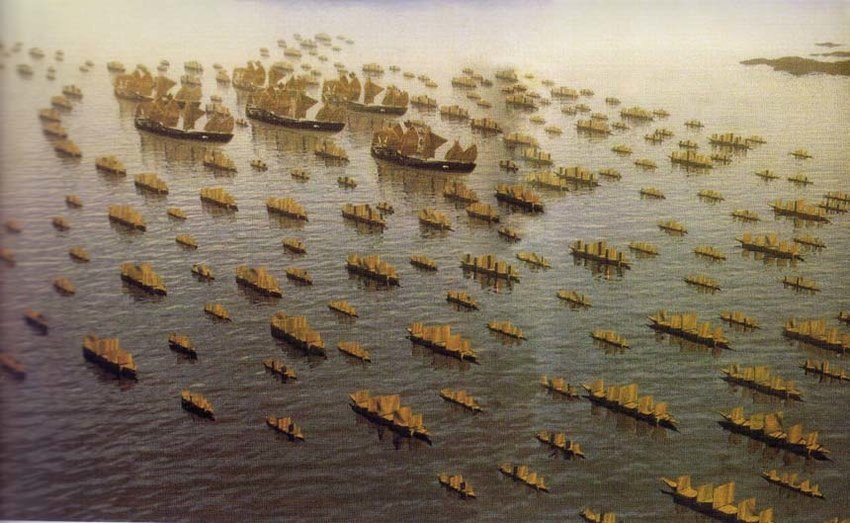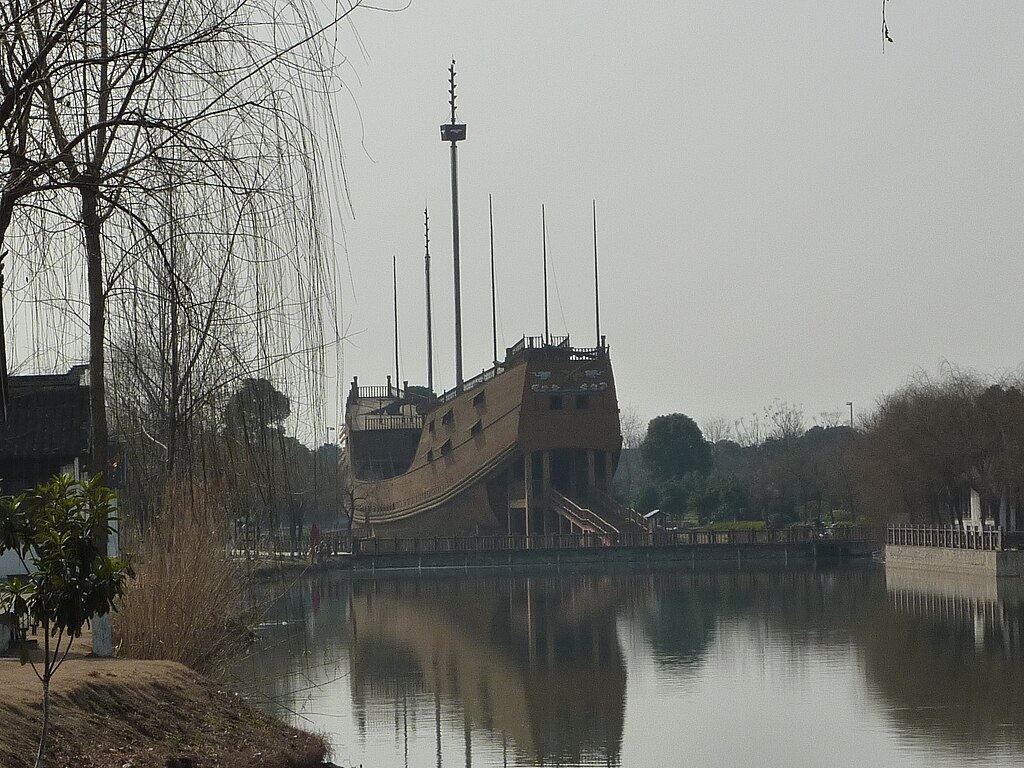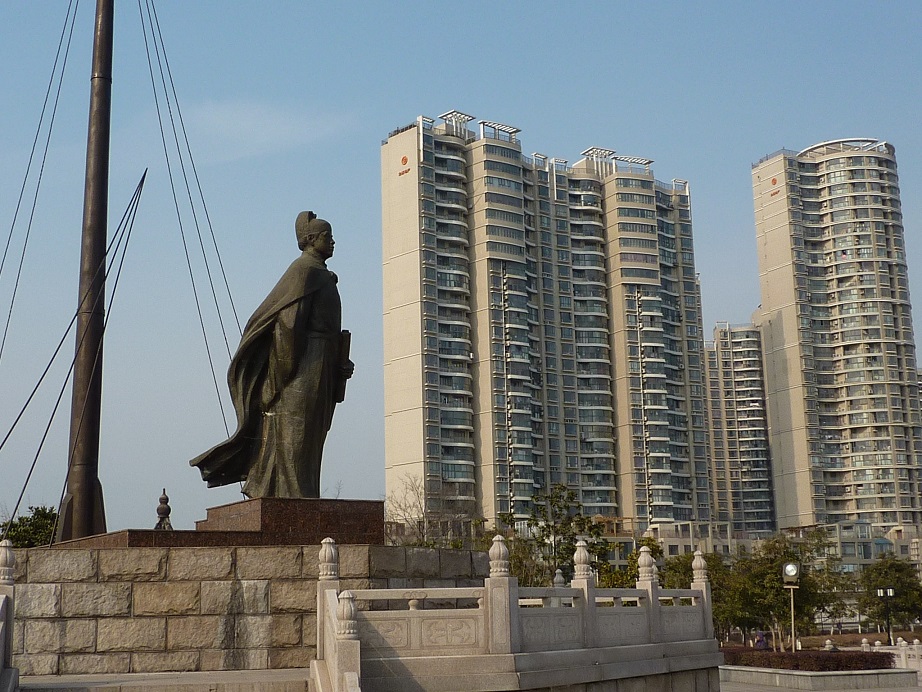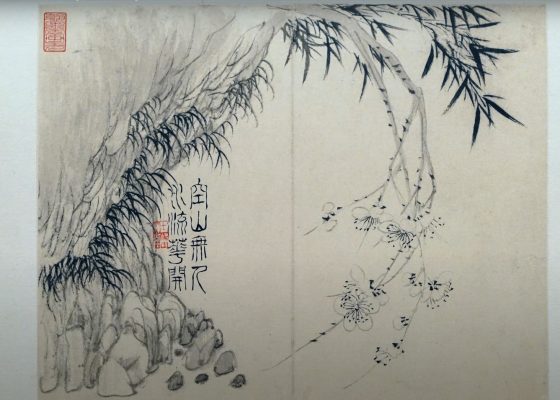
By Yang Wei
Eighty years before Vasco da Gama’s arrival in West India, a formidable Chinese navy ruled the China Sea and Indian Ocean, from Southeast Asia to the Persian Gulf and East Africa. Between the period from 1405 to 1433, China’s Ming dynasty launched seven voyages led by Admiral Zheng He to explore these vast regions, known then to the Chinese as the “West Oceans.” One such voyage typically featured over 300 vessels, including a number of “treasure ships” over 400 feet long, accompanied by a legion of supply ships, water tankers, warships with canons, and multioared patrol boats; the total personnel on the fleet numbered over 28,000.1 As has been pointed out, “It was a unique armada in the history of China— and the world—not to be surpassed until the invasion fleets of World War I sailed the seas.”2 Rather different from the Europeans, the Chinese armada never sought to establish colonial rule over these oceans by military force. It was by and large intended to facilitate peaceful diplomatic and trade relationships with foreign countries. China’s maritime supremacy vanished abruptly in the 1430s because of domestic objections, and the overseas expeditions were eventually ended by the court. All this happened only decades prior to the advent of the great age of European discovery and exploration.
The Eunuch Admiral
The Ming dynasty (1368–1644) was founded after the Chinese rebellion against the Mongols who ruled China during the previous century. In 1368, having established the new dynasty in Nanjing, Zhu Yuanzhang, the rebel leader, ordered his army to attack Beijing and ousted the Mongols who fled back to the Mongolian steppe outside the Great Wall. Loyalists to the fallen Mongol Yuan dynasty remained in provinces such as Yunnan, located in Southwest China. Originally named Ma He, Zheng He was born to a Muslim family in Yunnan. The family had migrated to China from Central Asia and had served in the Mongol administration in this region. Both Zheng He’s father and grandfather bore the title of hajji, indicating that they had completed pilgrimages to Mecca. In 1381, when the Ming army invaded Yunnan to subdue the Mongol remnants there, eleven-year-old Ma He was captured. The young prisoner of war was castrated and given, as a servant, to the court of Prince Yan, Zhu Di. The intimate company with the young prince bred a lifetime trust.
In 1399, Zhu Di launched a rebellion against his nephew, the emperor Jianwen, and usurped the throne three years later as the emperor Yongle. Having actively assisted Zhu Di in the civil war, Ma He was given the new name Zheng He by his lord for his military merits. The dethroned emperor Jianwen went missing in the last battle. Rumor had it that he absconded overseas. Some sources report that the new emperor organized the maritime expeditions to trace Jianwen’s whereabouts. But most historians discredit this story, for it is obviously unnecessary to launch seven costly voyages for this purpose. It is suggested that a variety of concerns motivated the missions, including an intent to display China’s military prowess; extend the new emperor’s political influence; seek trade opportunities and strategic allies against the Timurid Empire rising in Central Asia; facilitate an international order marked by peace and harmony; and perhaps most importantly, encourage tributes and endorsement by the various foreign states of the fragile legitimacy of the new emperor.
Zhu Di’s usurpation of the throne encountered resistance by the orthodox Confucian scholar-officials; instead, the new ruler entrusted eunuchs for important missions as imperial agents. In addition to having the emperor’s trust, Zheng He was known for his military talent, knowledge in the classics, strategic insights, and mature personality. Though born to a Muslim family, Zheng He was reportedly also a Buddhist. He also meticulously performed the state ritual sacrifice to the goddess of celestial consort, tianfei, a popular deity believed to provide protection for seafarers. He may have known Central Asian languages. Zheng He’s eclectic religious attitude and broadened cultural horizons made him a good candidate for the armada’s commander.5
The Treasure Fleet
The vessels needed by the expeditions were constructed at the Longjiang shipyard in the capital by the Yangzi River. The sailors were recruited from coastal provinces, mostly Fujian. During the Ming period, the most popular type of ocean-going ships was the shachuan, or “sandboats,” with flat-bottom hulls used for travel in the relatively shallow coastal waters. The Fujian shipwrights redesigned the junk for travel in the South China Sea and Indian Ocean. The largest of the junks constituting the fleet, called “treasure ships,” had nine staggered masts and twelve sails made of strong silk cloth. They featured pointed hulls as sharp as knives to cut through large waves, and had high prows and sterns with a keel on the bottom of the hull for enhanced stability in high seas. Wide, overhanging decks were also added: the lowest desk was filled with stones and earth for ballast; the second deck included living quarters for sailors and storage spaces; the third deck contained the kitchen, open space, and the operations bridge; and the fourth deck was a fighting platform, armed with twenty-four cast-bronze cannons. The ships were strengthened by strong prows to ram smaller boats, watertight bulwark compartments for added safety, and a balanced rudder that could be raised and lowered and functioned like an extra keel. These technological innovations were not introduced in Europe until the late eighteenth century.6
Rather wide and bulky, the treasure ships were approximately 390-408 feet in length and 160-166 feet in width. With a displacement of 10,000 tons or more, these were undoubtedly the largest wooden sailing ships ever built in world history, dwarfing Columbus’s flagship, the St. Maria, which, in contrast, was only 85 feet in length. The actual size of these treasure ships had been controversial, but in 1957, archeologists found in the Longjiang shipyard a huge 36.3-foot-long rudder, a discovery that supported the accuracy of existing records. The reported size of the treasure ships is also consistent with the size of the dry docks at Longjiang, two of them 210 feet wide, big enough to accommodate a ship 166 feet wide.7
In addition to the colossal treasure ships, the fleet was composed of other types of specialized vessels of diverse sizes, including the eight-masted “horse ships” that carried horses and building materials needed to repair the fleet at sea, the seven-masted “supply ships” containing food staples for the crew, “troop transports” that accommodated the solders, and fresh water tankers that supplied enough water for continual sailing for one month or longer. The fleet also had two types of warships designed for use against pirates. The ships utilized large flags, signal bells, drums, gongs, lanterns, and carrier pigeons to communicate with one another during the journey.8 Eunuchs of different ranks were the top fleet commanders. Fleet crews included military officers, personnel from the Ministry of Rites (in charge of foreign affairs), Ministry of Revenue senior secretaries, astrologers and geomancers, translators knowledgeable of Arabic and other Central Asian languages, and a number of medical officers and pharmacologists whose task was to collect herbs. Regular seamen and soldiers, as well as ironsmiths, caulkers, and carpenters to provide needed repairs, constituted the rest of the crew.
The Voyages
The 1405 maiden voyage of the fleet consisted of 317 ships, and over 27,000 men. The fleet assembled at Liujiagang, a port on the Yangzi River near Suzhou. The ships carried large cargo to be traded abroad, including thousands of bolts of fine silk, embroideries, cotton cloth, gold, iron, salt, hemp, tea, wine, oil, porcelain, and candles. The fleet sailed along China’s southeast coast to Champa, Java, Malacca, Semudera, and Lambri in northern Sumatra, and then crossed the Indian Ocean to the major trading ports on the southwest coast of India, including Ceylon, Quilon, and Calicut. The scene of Zheng He’s 300-vessel fleet at sea, spreading out over many square miles, must have been awe-inspiring to eyewitnesses. While engaging in trade with the various ports, the fleet impressed the local regimes. Ambassadors from Calicut, Semudera, Quilon, Malacca, and other states joined the returning fleet to Nanjing to pay tribute. The tribute trade had long been an integral part of the Chinese imperial diplomatic system. The foreign envoys, often a combination of diplomats and merchants, came to the emperor’s court to offer local specialties, and the emperor would give far more expensive gifts in return and entertain the envoys with great hospitality.

On the armada’s way home, they encountered the Chinese pirate Chen Zuyi, who had dominated the Malacca Strait and posed a threat to the trade routes. Zheng He’s fleet defeated the pirates; destroyed their lair in Palembang; and captured Chen, who was escorted to Nanjing and executed there. This military operation cleared the passage from the South China Sea to the Indian Ocean.
The second voyage was in 1407. The fleet visited Siam, Java, and northern Sumatra, then again headed for the Indian Ocean. In Calicut, the Chinese emissaries presided over the formal investiture of the Calicut king with Chinese titles and gifts for the king and his retinue. On their return, the fleet visited Siam and Java, where Zheng He was involved in a power struggle between two rival native rulers. The third expedition began in 1409 and followed the previous routes to India. Zheng He’s activities in Ceylon revealed his eclectic attitude concerning religion. Although Zheng He was a Muslim, he visited a local Buddhist temple and erected a stone with inscriptions in Chinese, Persian, and Tamil to commemorate the journey. In 1411, on the return from Calicut, the fleet had a military confrontation with Alagakkonara, the king of Ceylon. Alagakkonara tried to kidnap Zheng He and plunder the fleet, and Chinese troops then attacked the Sinhalese palace and captured the king, who was taken with his family to Nanjing. The Yongle emperor later released them back to Ceylon, but the Chinese supported another local regime considered legitimate.

The fourth voyage in 1413 and 1415 explored further regions. After visiting India, the fleet, for the first time, continued to the Maldives and Hormuz in the Persian Gulf. A subfleet may have visited the port of Aden in what is now modern-day Yemen, as well as Bengal. Again, Zheng He was entangled in a local conflict in Semudera on their return. A usurper who murdered the king was defeated, captured, and executed in Nanjing; the Chinese idea of political legitimacy and international order was declared through their involvement in a local power struggle. After this expedition, eighteen states from today’s Việt Nam to the distant coast of East Africa sent tribute envoys to the Ming court. Chinese political power and influence reached its height thanks to Zheng He’s voyages.
The fifth voyage that began in 1417 was intended to bring home the envoys of the eighteen states. The armada visited the ports on the East African coast, and from there Zheng He brought back more ambassadors with a cargo of tribute from Africa, including lions, leopards, dromedary camels, ostriches, rhinoceroses, antelopes, and giraffes. When Zheng He returned to the capital, the city gate had to be enlarged so that the tall giraffes could enter. The Chinese believed that the giraffes were legendary beasts called qilin who were mentioned in ancient Confucian classics as epitomizing virtue and prosperity. Greatly pleased, the emperor constructed a royal zoo to accommodate exotic animals and plants. The sixth expedition in 1421 escorted the ambassadors who had stayed in China for years back home. The fleet split in Sumatra. While Zheng He returned, parts of his fleet visited Hormuz, Dhufar, Aden, Mogadishu, and Brava on the Somali coast. Again, many more envoys accompanied the fleet back to Nanjing.
After the demise of the Yongle emperor, the voyages were stopped for several years. One last voyage was ordered by the Xiande emperor in 1431. A partial objective of the mission was the restoration of peaceful relations between the Siam and Malay kingdoms of Malacca. In the imperial edict Zheng He brought to the Siamese king, the Chinese emperor scolded the ruler for harassing Malacca and for detaining the Malaccan king on his way to the Ming capital. Restoring peace and order in the South China Sea was the major mission of the voyage. Zheng He died on India’s west coast during the return journey; his deputy, eunuch Wang Jinghong, led the fleet home in 1433. Zheng He may have been buried at sea in accordance with Islamic tradition. A symbolic tomb, containing the admiral’s caps and clothes, was built right outside of Nanjing and remains there.
The Accomplishments
Zheng He’s voyages took place in an era of costly military expansions and construction projects, including wars against the Mongols and Việt Nam, as well as the building of the new capital city (Beijing). Due to concerns about high costs fueled by the objections of Confucian scholar-officials, the imperial government stopped these voyages for good in the 1430s. No records suggest the establishment of permanent embassies in the regions the fleet visited. Nevertheless, the missions did succeed in extending the Ming court’s influence, demonstrating China’s military power, enriching Chinese knowledge of the empire’s “far west,” encouraging tribute trade, combating pirates, and promulgating the Chinese concept of world order and political legitimacy. A “Pax Sinica” (Chinese peace) was maintained across the oceans during these decades. Hundreds of foreign envoys visited China, including eleven kings, all entertained well by the emperor. Several kings stayed in China for years and died there, including the king of Brunei and the king of Sulu in the Philippines. Their tombs have become symbolic relics testifying to generally positive international relations between China and neighboring polities. The voyages also left a cultural imprint in the regions they visited. Besides the known stone steles commemorating the journeys, Zheng He and his fleet remained an enduring theme in popular Southeast Asia folktales. In 2003, an iron statue of Zheng He was discovered in India, which strikingly resembles another statue of his excavated in Fujian, China.10 Zheng He’s voyages also bequeathed a rich maritime legacy to later generations. Two surviving records of the expeditions, the Overall Survey of the Ocean Shores (yin ya sheng lan) by Ma Huan and the Description of the Starry Raft (xin cha sheng lan) by Fei Xin, provide detailed accounts of the voyages and the various states the fleet visited.11 These texts also record the distinctive Chinese nautical technologies of the time, including methods of measuring distance and depth of the ocean, as well as technologies of navigation through the combined use of maritime compass, celestial observation, and time calculation.
International trade was a crucial dimension of these expeditions, though the actual economic impact was difficult to evaluate. Zheng He’s fleet traded China’s products for foreign luxuries as well as products for daily use, especially spices, exotic wood, and medicines, to be brought back to the capital. Although these goods were mainly presented to the emperor for his consumption and disposal, foreign emissaries who came to China were permitted to trade with locals in the capital for handsome profits that also allowed ordinary Chinese to benefit from international trade.
Contested Legacy
Attitudes about Zheng He’s expeditions had been conflicted since the fifteenth century. Confucian scholar-officials were disturbed by the emperor’s trust in eunuchs, and saw such costly expeditionary activities as a meaningless waste of resources. They destroyed Zheng He’s maritime log and deliberately left the treasure ships unrepaired to prevent their possible future use. Imperial China’s seafaring competency was never revived, and these voyages were rarely mentioned later in official dynastic records. Although part of Zheng He’s nautical charts was reprinted in a seventeenth- century encyclopedia, these expeditions were by and large forgotten for centuries until the early twentieth century, when modern Chinese intellectuals “rediscovered” China’s maritime tradition. Since then, Zheng He had been reinterpreted as China’s “great maritime giant” who accomplished glorious overseas explorations comparable to the European voyages of discovery that marked the advent of the modern era.12 Studies of maritime routes, technological achievements, and expansion of diplomatic relations associated with the voyages were sparked by nationalist pride and renewed interest in international relations in the twentieth and twenty-first centuries. In the opening ceremony of the 2008 Beijing Olympic Games, Zheng He’s epic voyages were theatrically represented as part of China’s grand historical tradition.
Zheng He’s journeys also fascinated the nonscholarly world. In 2002, a retired British naval officer, Gavin Menzies, published his amateur historical study, asserting that Zheng He’s subfleet discovered the Americas before Columbus; his book was soon popularized in TV documentaries.13 Most professional historians believe Menzies’s story to be pure fantasy and not based on any Chinese historical sources. For example, the 1418 nautical chart that Menzies cites that includes the Americas and Antarctica is believed to be a fake.14 Zheng He’s voyages also remained a significant part of many people’s memories and identities. On East African and Australian coasts, there are reports of fair-skinned residents with vocabularies and styles of architecture different from other natives who claim to be descendents of Zheng He’s sailors. In 2005, a Kenyan girl even received a Chinese government’s scholarship to study in Nanjing because of her repeated requests to visit her “ancestors’ country” as an offspring of Zheng He’s seamen.15
An enduring topic of international history, Zheng He’s voyages marked the acme of China’s seafaring; but for many, it also implies the “missed opportunity” China had on the eve of the modern era. Shortly after the conclusion of these monumental maritime achievements, China turned inward and subsequently failed to successfully compete with rising European powers. But, it is clear that fifteenth-century China maritime history is largely about Zheng He and the effects of his voyages. Although the court ended official expeditions, international trade and local markets continued to flourish along these oceans. For instance, Malacca—Zheng He’s most important port after those in China—was transformed into a crucial hub of an expanding network of trade that extended across Southeast Asia and up to China’s coasts in that century. In this regard, Zheng He was only the most prominent of the many who together changed the cultural geography of these oceans through varied maritime engagements. Further studies of trade and international connections in the fifteenth century and beyond may reveal an Asia that is even more different than one imagined by Eurocentric scholarship.
NOTES
Denis Twitchett & Frederick W. Mote, eds., The Cambridge History of China: The Ming Dynasty 1368–1644, Part 1, Vol. 7 (Cambridge: Cambridge University Press, 1988), 232.
Louise Levathes, When China Ruled the Seas: The Treasure Fleet of the Dragon Throne, 1405–1433 (Oxford: Oxford University Press, 1994), 20.
Edward L. Dreyer, Zheng He: China and the Oceans in the Early Ming Dynasty, 1405– 1433 (New York: Pearson Longman, 2007).
Twitchett and Mote, 232.
Levathes, 57–74.
Guan Jincheng, “The Ships of Zheng He’s Voyages to the West Oceans” (郑和下西 洋的船) Zheng He Yanjiu bainian lunwen ji 郑和研究百年论文集 (Beijing: Beijing Daxue Chubanshe, 2005), 1, 68–71. Referred to as ZHYJ hereafter. See also Levathes, 75–86.
Zhou Shide, “Assessment of the Rudder from the Treasure Shipyard and the Inference of Zheng He’s Treasure Ships” (从宝船厂舵杆的鉴定推论郑和宝船) in ZHYJ, 72–81. See also Joseph Needham et al., Science and Civilization in China Part 3, Vol. 4 (Cambridge: Cambridge University Press, 1971), 480–482.
Guan Jincheng, 75–86.
Ibid., 233–235. See also Levathes, 107–122.
“A Gold Covered Statue of Zheng He Found in the West Coast of India “(郑和鎏 金像惊现印度西海岸),” People’s News Agency, last modified December 13, 2004, http://tinyurl.com/ozrmndj. See also Wan Ming, “The Ming Statue of Zheng He: Revisit of the Colored Statues in Xianyin Palace, Changle, Fujian Province (明代郑 和的塑像: 福建长乐显应宫出土彩塑再探),” Journal of the Forbidden City Museum (故宫博物院院刊) vol. 3 (2005).
For English translation of these texts, see Ma Huan: Ying Yai Sheng Lan (The Overall Survey Of The Ocean Shores), trans. with notes by J.V. G. Mills (Cambridge: Cambridge University Press, 1970); and W. W. Rockhill, “Notes on the Relations and Trade of China with the Eastern Archipelago and the Coast of the Indian Ocean during the Fourteenth Century Part II,” T’oung Pao 21 (1915), 236–71.
Liang Qichao, “The Biography of Zheng He, the Great Navigator of Our Homeland” (祖国大航海家郑和传), originally published in 1904 in ZHYJ, 1.
Gavin Menzies, 1421: The Year China Discovered the World (London: Bantam Press, 2002).
For refutation from scholars outside the United States, in particular Geoff Wade, see http://tinyurl.com/23jzpd. For Chinese scholars’ evaluation, see http://tinyurl.com/ p4gha46.
“Kenyan Descendant of Zheng He’s Seamen Comes to Nanjing for College,” Xinhua News Agency, last modified September 20, 2005,
Source: The Association for Asian Studies












Cancel anytime


Using our website
You may use the The Middle Land website subject to the Terms and Conditions set out on this page. Visit this page regularly to check the latest Terms and Conditions. Access and use of this site constitutes your acceptance of the Terms and Conditions in-force at the time of use.
Intellectual property
Names, images and logos displayed on this site that identify The Middle Land are the intellectual property of New San Cai Inc. Copying any of this material is not permitted without prior written approval from the owner of the relevant intellectual property rights.
Requests for such approval should be directed to the competition committee.
Please provide details of your intended use of the relevant material and include your contact details including name, address, telephone number, fax number and email.
Linking policy
You do not have to ask permission to link directly to pages hosted on this website. However, we do not permit our pages to be loaded directly into frames on your website. Our pages must load into the user’s entire window.
The Middle Land is not responsible for the contents or reliability of any site to which it is hyperlinked and does not necessarily endorse the views expressed within them. Linking to or from this site should not be taken as endorsement of any kind. We cannot guarantee that these links will work all the time and have no control over the availability of the linked pages.
Submissions
All information, data, text, graphics or any other materials whatsoever uploaded or transmitted by you is your sole responsibility. This means that you are entirely responsible for all content you upload, post, email or otherwise transmit to the The Middle Land website.
Virus protection
We make every effort to check and test material at all stages of production. It is always recommended to run an anti-virus program on all material downloaded from the Internet. We cannot accept any responsibility for any loss, disruption or damage to your data or computer system, which may occur while using material derived from this website.
Disclaimer
The website is provided ‘as is’, without any representation or endorsement made, and without warranty of any kind whether express or implied.
Your use of any information or materials on this website is entirely at your own risk, for which we shall not be liable. It is your responsibility to ensure any products, services or information available through this website meet your specific requirements.
We do not warrant the operation of this site will be uninterrupted or error free, that defects will be corrected, or that this site or the server that makes it available are free of viruses or represent the full functionality, accuracy and reliability of the materials. In no event will we be liable for any loss or damage including, without limitation, loss of profits, indirect or consequential loss or damage, or any loss or damages whatsoever arising from the use, or loss of data, arising out of – or in connection with – the use of this website.
Last Updated: September 11, 2024
New San Cai Inc. (hereinafter “The Middle Land,” “we,” “us,” or “our”) owns and operates www.themiddleland.com, its affiliated websites and applications (our “Sites”), and provides related products, services, newsletters, and other offerings (together with the Sites, our “Services”) to art lovers and visitors around the world.
This Privacy Policy (the “Policy”) is intended to provide you with information on how we collect, use, and share your personal data. We process personal data from visitors of our Sites, users of our Services, readers or bloggers (collectively, “you” or “your”). Personal data is any information about you. This Policy also describes your choices regarding use, access, and correction of your personal information.
If after reading this Policy you have additional questions or would like further information, please email at middleland@protonmail.com.
PERSONAL DATA WE COLLECT AND HOW WE USE IT
We collect and process personal data only for lawful reasons, such as our legitimate business interests, your consent, or to fulfill our legal or contractual obligations.
Information You Provide to Us
Most of the information Join Talents collects is provided by you voluntarily while using our Services. We do not request highly sensitive data, such as health or medical information, racial or ethnic origin, political opinions, religious or philosophical beliefs, trade union membership, etc. and we ask that you refrain from sending us any such information.
Here are the types of personal data that you voluntarily provide to us:
As a registered users or customers, you may ask us to review or retrieve emails sent to your business. We will access these emails to provide these services for you.
We use the personal data you provide to us for the following business purposes:
Information Obtained from Third-Party Sources
We collect and publish biographical and other information about users, which we use to promote the articles and our bloggers who use our sites. If you provide personal information about others, or if others give us your information, we will only use that information for the specific reason for which it was provided.
Information We Collect by Automated Means
Log Files
The site uses your IP address to help diagnose server problems, and to administer our website. We use your IP addresses to analyze trends and gather broad demographic information for aggregate use.
Every time you access our Site, some data is temporarily stored and processed in a log file, such as your IP addresses, the browser types, the operating systems, the recalled page, or the date and time of the recall. This data is only evaluated for statistical purposes, such as to help us diagnose problems with our servers, to administer our sites, or to improve our Services.
Do Not Track
Your browser or device may include “Do Not Track” functionality. Our information collection and disclosure practices, and the choices that we provide to customers, will continue to operate as described in this Privacy Policy, whether or not a “Do Not Track” signal is received.
HOW WE SHARE YOUR INFORMATION
We may share your personal data with third parties only in the ways that are described in this Privacy Policy. We do not sell, rent, or lease your personal data to third parties, and We does not transfer your personal data to third parties for their direct marketing purposes.
We may share your personal data with third parties as follows:
There may be other instances where we share your personal data with third parties based on your consent.
HOW WE STORE AND SECURE YOUR INFORMATION
We retain your information for as long as your account is active or as needed to provide you Services. If you wish to cancel your account, please contact us middleland@protonmail.com. We will retain and use your personal data as necessary to comply with legal obligations, resolve disputes, and enforce our agreements.
All you and our data are stored in the server in the United States, we do not sales or transfer your personal data to the third party. All information you provide is stored on a secure server, and we generally accepted industry standards to protect the personal data we process both during transmission and once received.
YOUR RIGHTS/OPT OUT
You may correct, update, amend, delete/remove, or deactivate your account and personal data by making the change on your Blog on www.themiddleland.com or by emailing middleland@protonmail.com. We will respond to your request within a reasonable timeframe.
You may choose to stop receiving Join Talents newsletters or marketing emails at any time by following the unsubscribe instructions included in those communications, or you can email us at middleland@protonmail.com
LINKS TO OTHER WEBSITES
The Middle Land include links to other websites whose privacy practices may differ from that of ours. If you submit personal data to any of those sites, your information is governed by their privacy statements. We encourage you to carefully read the Privacy Policy of any website you visit.
NOTE TO PARENTS OR GUARDIANS
Our Services are not intended for use by children, and we do not knowingly or intentionally solicit data from or market to children under the age of 18. We reserve the right to delete the child’s information and the child’s registration on the Sites.
PRIVACY POLICY CHANGES
We may update this Privacy Policy to reflect changes to our personal data processing practices. If any material changes are made, we will notify you on the Sites prior to the change becoming effective. You are encouraged to periodically review this Policy.
HOW TO CONTACT US
If you have any questions about our Privacy Policy, please email middleland@protonmail.com
The Michelin brothers created the guide, which included information like maps, car mechanics listings, hotels and petrol stations across France to spur demand.
The guide began to award stars to fine dining restaurants in 1926.
At first, they offered just one star, the concept was expanded in 1931 to include one, two and three stars. One star establishments represent a “very good restaurant in its category”. Two honour “excellent cooking, worth a detour” and three reward “exceptional cuisine, worth a
Thank you for your participation,
please Log in or Sign up to Vote

123Sign in to your account